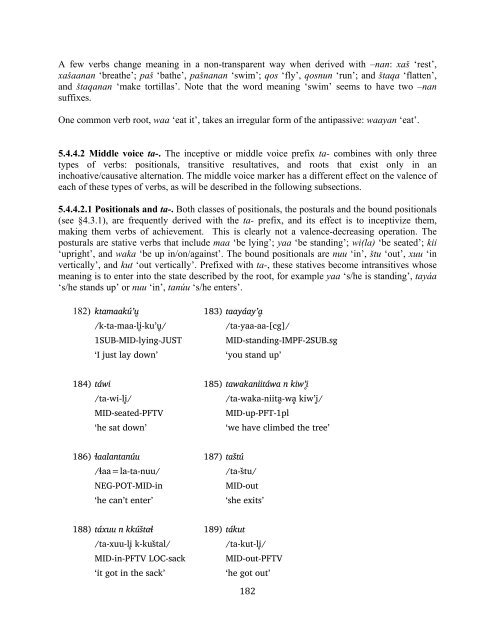The phonology and morphology of Filomeno Mata Totonac
The phonology and morphology of Filomeno Mata Totonac
The phonology and morphology of Filomeno Mata Totonac
Create successful ePaper yourself
Turn your PDF publications into a flip-book with our unique Google optimized e-Paper software.
A few verbs change meaning in a non-transparent way when derived with –nan: xa# ‘rest’,<br />
xa#aanan ‘breathe’; pa# ‘bathe’, pa#nanan ‘swim’; qos ‘fly’, qosnun ‘run’; <strong>and</strong> #taqa ‘flatten’,<br />
<strong>and</strong> #taqanan ‘make tortillas’. Note that the word meaning ‘swim’ seems to have two –nan<br />
suffixes.<br />
One common verb root, waa ‘eat it’, takes an irregular form <strong>of</strong> the antipassive: waayan ‘eat’.<br />
5.4.4.2 Middle voice ta-. <strong>The</strong> inceptive or middle voice prefix ta- combines with only three<br />
types <strong>of</strong> verbs: positionals, transitive resultatives, <strong>and</strong> roots that exist only in an<br />
inchoative/causative alternation. <strong>The</strong> middle voice marker has a different effect on the valence <strong>of</strong><br />
each <strong>of</strong> these types <strong>of</strong> verbs, as will be described in the following subsections.<br />
5.4.4.2.1 Positionals <strong>and</strong> ta-. Both classes <strong>of</strong> positionals, the posturals <strong>and</strong> the bound positionals<br />
(see §4.3.1), are frequently derived with the ta- prefix, <strong>and</strong> its effect is to inceptivize them,<br />
making them verbs <strong>of</strong> achievement. This is clearly not a valence-decreasing operation. <strong>The</strong><br />
posturals are stative verbs that include maa ‘be lying’; yaa ‘be st<strong>and</strong>ing’; wi(la) ‘be seated’; kii<br />
‘upright’, <strong>and</strong> waka ‘be up in/on/against’. <strong>The</strong> bound positionals are nuu ‘in’, #tu ‘out’, xuu ‘in<br />
vertically’, <strong>and</strong> kut ‘out vertically’. Prefixed with ta-, these statives become intransitives whose<br />
meaning is to enter into the state described by the root, for example yaa ‘s/he is st<strong>and</strong>ing’, tayáa<br />
‘s/he st<strong>and</strong>s up’ or nuu ‘in’, tanúu ‘s/he enters’.<br />
182) ktamaakú*u& 183) taayáay’a&<br />
/k-ta-maa-li&-ku’u&/ /ta-yaa-aa-[cg]/<br />
1SUB-MID-lying-JUST MID-st<strong>and</strong>ing-IMPF-2SUB.sg<br />
‘I just lay down’ ‘you st<strong>and</strong> up’<br />
184) táwi 185) tawakaniitáwa n kiw’i&<br />
/ta-wi-li&/ /ta-waka-niita&-wa& kiw’i&/<br />
MID-seated-PFTV MID-up-PFT-1pl<br />
‘he sat down’ ‘we have climbed the tree’<br />
186) "aalantanúu 187) tas%tú<br />
/#aa=la-ta-nuu/ /ta-s"tu/<br />
NEG-POT-MID-in MID-out<br />
‘he can’t enter’ ‘she exits’<br />
188) táxuu n kkús%ta" 189) tákut<br />
/ta-xuu-li& k-kus"tal/ /ta-kut-li&/<br />
MID-in-PFTV LOC-sack MID-out-PFTV<br />
‘it got in the sack’ ‘he got out’<br />
! ",#!

















